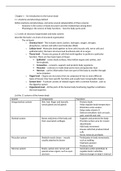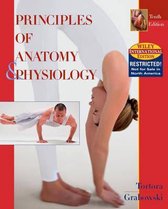Chapter 1 – An introduction to the human body
1.1 Anatomy and physiology defined
Define anatomy and physiology, and name several subspecialties of these sciences
- Anatomy is the science of body structures and the relationships among them
- Physiology is the science of body functions – how the body parts work
1.2 Levels of structural organisation and body systems
Describe the body’s six levels of structural organisation
- The six levels
o Chemical level - This includes atoms (carbon, hydrogen, oxygen, nitrogen,
phosphorus, calcium and sulfur) and molecules (DNA)
o Cellular level - Molecules bind together to form cells (muscle cells, nerve cells and
epithelial cells), the basic structural and functional units of an organ
o Tissue level – Tissues are group of cells that work together to perform a particular
function. There are four basic types of tissue:
Epithelial – covers body surfaces, lines hollow organs and cavities, and
forms glands.
Connective – connects, supports and protects body organisms
Muscular – contracts to make body parts move and generates heat
Nervous – carries information from one part of the body to another through
nerve impulses
o Organ level – Organs are structures that are composed of two or more different
types of tissues: they have specific functions and usually have recognisable shapes.
o System level – A system consists of related organs with a common function , such as
the digestive system
o Organismal level – All the parts of the human body functioning together constitutes
the total organism
List the 11 systems of the human body
System Components Functions
Integumentary system Skin, hair, finger and toenails, - Protects body
sweat glands and oil glands - Helps regulate body temperature
- Eliminates some wastes
- Helps make vitamin D
- Detects sensations such as touch,
pain, warmth and cold
Skeletal system Bones and joints of the body and - Supports and protects the body
their associated cartilages - Provides surface area for muscle
attachments
- Aids body movement
- Houses cells that produce blood
cells
- Stores minerals and lipids
Muscular system Skeletal muscle tissue – muscle - Participates in body movements,
usually attached to bones such as walking
- Maintains posture
- Produces heat
Nervous system Brains, spinal cord, nerves and - Generates action potentials to
special sense organs, such as eyes regulate body’s activities
and ears - Detects changes in body’s internal
, and external environments,
interprets changes, and responds
by causing muscular contraction
or glandular secretions
Endocrine system Hormone-producing glands and - Regulates body activities by
hormone-producing cells in several releasing hormones
other organs
Cardiovascular system Blood, heart and blood vessels - Heart pumps blood through blood
vessels
- Blood carries oxygen and nutrients
to cells and carbon dioxide and
wastes away from cells and helps
regulate acid-base balance,
temperature and water content of
body fluids
- Blood components help defend
against disease and repair
damaged blood vessels
Lymphatic system and Lymphatic fluid and vessels; spleen, - Returns proteins and fluid to
immunity thymus, lymph nodes and tonsils; B blood
cells and T cells - Carries lipids from gastrointestinal
tract to blood
- Contains sites of maturation and
proliferation of B cells and T cells
that protect against disease-
causing microbes
Respiratory system Lungs, pharynx, larynx, trachea and - Transfers oxygen from inhaled air
bronchial tubes to blood and carbon dioxide from
blood to exhale air
- Helps regulate acid-base balance
of body fluids
- Air flowing out of lungs through
vocal cords produces sounds
Digestive system Mouth, pharynx, oesophagus, - Achieves physical and chemical
stomach, small and large breakdown of food
intestines, and anus; also includes - Absorbs nutrients
glands that assist in digestive - Eliminates solid wastes
processes, such as salivary glands,
liver, gall bladder and pancreas
Urinary systems Kidneys, ureters, urinary bladder - Produces, stores and eliminates
and urethra urine
- Eliminates wastes and regulates
volume and chemical composition
of blood
- Helps maintain the acid-base
balance of the body fluids
- Maintains body’s mineral balance
- Helps regulate production of red
blood cells
Reproductive systems Male: testes, epididymides, ductus - Gonads produce gametes (sperm
deferens, seminal vesicles, prostate or oocytes) that unite to form a
, and penis new organism
Female: ovaries, uterine tubes, - Gonads also release hormones
uterus, vagina and mammary that regulate reproduction and
glands other body processes
- Associated organs transport and
store gametes
- Mammary glands produce milk
1.3 Characteristics of the living human organism
Define the important life processes of the human body
- Metabolism – all chemical processes that occur in the body. Catabolism is the breakdown of
molecules and anabolism is the building up of molecules.
- Responsiveness – the body’s ability to detect and respond to changes.
- Movement – this is the motion of the whole body, individual organs, single cells and tiny
structures inside cells.
- Growth – an increase in body size that results from an increase in the size of existing cells, an
increase in the number of cells, or both
- Differentiation – the development of a cell from an unspecialised to a specialised state. Such
undifferentiated cells are known as stem cells.
- Reproduction – the formation of new cells for tissue growth, repair or replacement, or the
production of a new individual.
1.4 Homeostasis
Define homeostasis
- Homeostasis is the condition of equilibrium in the body’s internal environment due to the
constant interaction of the body’s many regulatory processes
- The fluid within cells is intracellular fluid (ICF), the fluid outside body cells is extracellular
fluid (ECF) and the fluid that fills narrow spaces between cells of tissues is the interstitial
fluid.
- The nervous and endocrine systems act together or separate to regulate homeostasis. The
nervous system sends nerve impulses and the endocrine system secretes hormones.
Describe the components of a feedback system
- A feedback system is a cycle of events in which the status of a body condition is monitored,
evaluated, changed, remonitored, and re-evaluated and so on.
o A receptor is a body structure that monitors changes in a controlled condition and
sends input to a control centre. (afferent pathway since the information flows
towards the control centre)
o A control centre in the body, e.g. the brain, sets the range of values within which a
controlled condition should be maintained, evaluates the input it receives from
receptors, and generates output commands when they are needed. (efferent
pathway since the information flows away from the control centre)
o An effector is a body structure that receives output from the control centre and
produces a response or effect that changes the controlled condition.
Contrast the operation of negative and positive feedback systems
Negative feedback Positive feedback
Reverses a change in a controlled situation Strengthens or reinforces a change in a controlled
condition
The activity of the effector goes against the original The activity of the effector reinforces the original
stimulus stimulus
, Regulates conditions in the body that remain fairly Reinforces conditions that do not happen very often
stable over long periods
Example: Example:
Blood pressure (BP) increases → Baroreceptors Contractions of wall of uterus stretch cervix →
send nerve impulses → brain interprets input and stretch-sensitive nerve cells in cervix send nerve
sends nerve impulses to heart and blood vessels → impulses → brain interprets input and releases
heart rate decreases, BP decreases oxytocin→ muscles in wall contract more forcefully
→ baby’s body stretches cervix more. Cycle stops
when baby is born
Explain how homeostatic imbalances are related to disorder
- Many diseases are the result of years of poor health behaviour that interferes with the
body’s natural drive to maintain homeostasis.
- The normal balance among all of the body processes may be disturbed if one or more
components of the body lose their ability to contribute to homeostasis
- If the homeostatic imbalance is moderate, a disorder or disease may occur; if it is sever,
death may result
- A disorder is any abnormality of structure or function. A disease is a more specific term for
an illness characterised by a recognisable set of signs and symptoms.
1.5 Basic anatomical terminology
Describe the anatomical position
- Descriptions of any region or part of the human body assume that it is in a standard position
of reference called the anatomical position. In the anatomical position, the subject stands
erect facing the observer, with the head level and the eyes facing directly forward. The feet
are flat on the floor and directed forward, and the upper limbs are at the sides with the
palms turned forward.
- If the body is lying face down, it is in the prone position. If the body is lying face up, it is in
the supine position
Define each directional term used to describe the human body
Directional term Definition Example of use
Superior Toward the head, or the upper part of The heart is superior to the
a structure liver
Inferior Away from the head, or the lower part The stomach is inferior to
of a structure the lungs
Anterior Nearer to or at the front of the body The sternum (breastbone) is
anterior to the heart
Posterior Nearer to or at the back of the body The oesophagus is posterior
to the trachea
Medial Nearer to the midline The ulna is medial to the
radius
Lateral Farther from the midline The lungs are lateral to the
heart
Intermediate Between two structures The transverse colon is
intermediate between the
ascending and descending
colons
Ipsilateral On the same side of the body as The gallbladder and
another structure ascending colon are
ipsilateral





